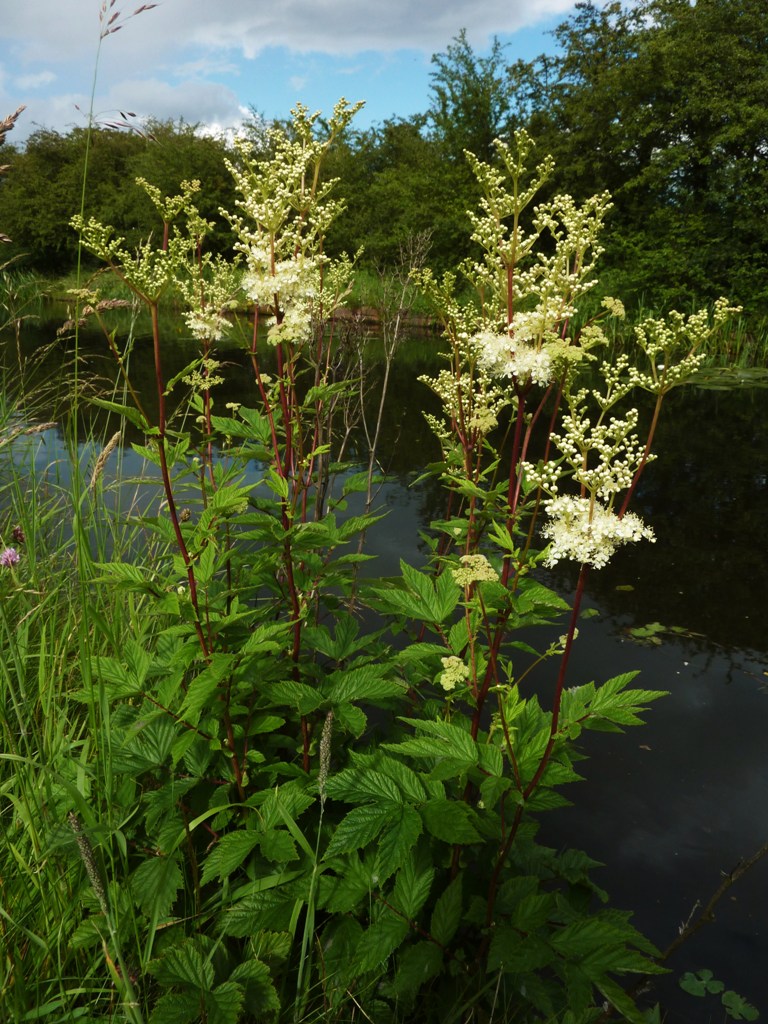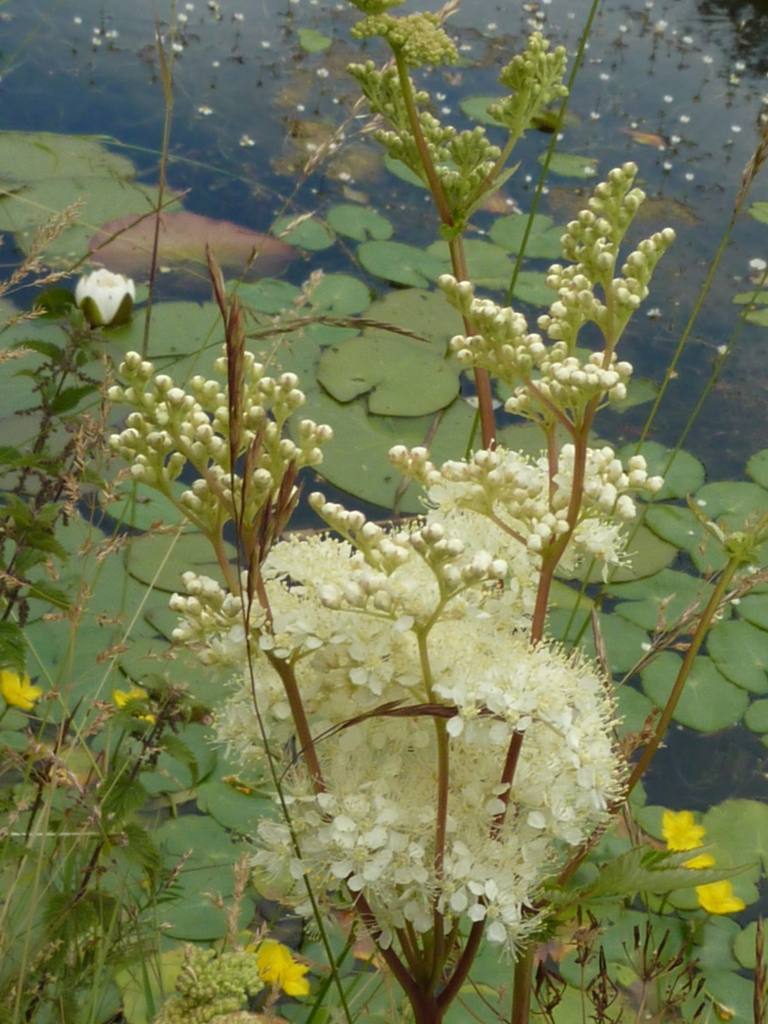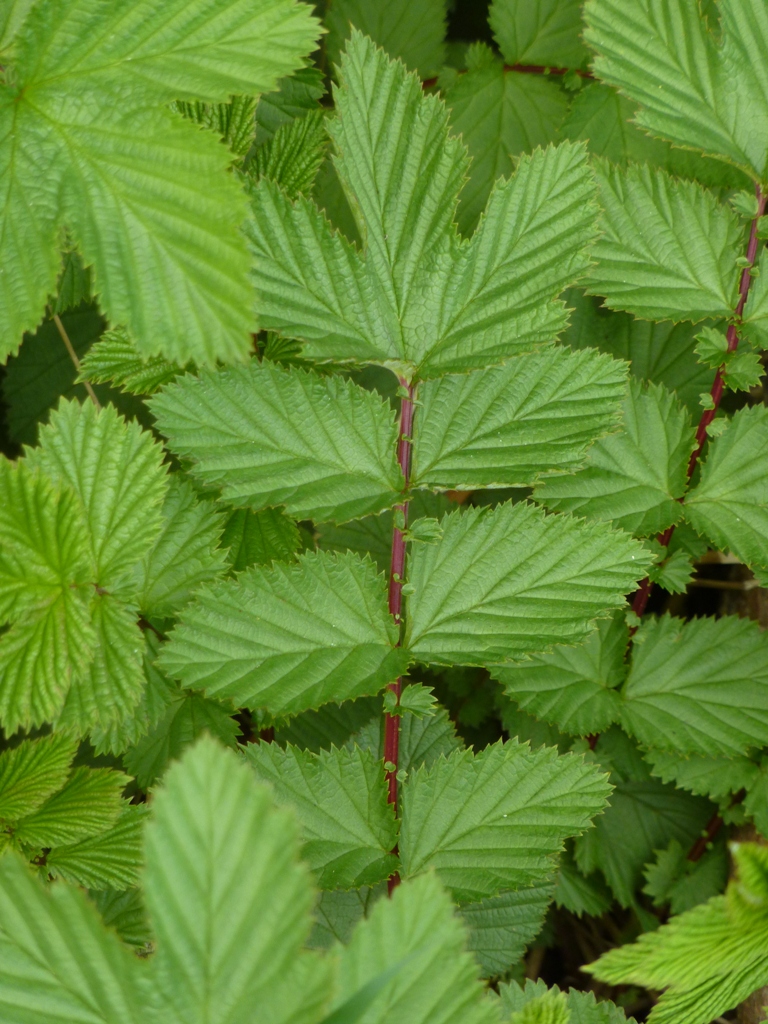Whenever there are medicinal uses you’ll find the text with a pink background. Ornamental and Edible uses are with green background and (specific) wildlife uses (which is nearly always of course, especially the flowers) a blue background. Most information, with thanks from Wikipedia, PFAF and other brilliant websites out there.
Many pictures with thanks to Mike Poulton and Matt Summers.
Note: This is an educational blog about the ethnobotanical uses of native plants and most information comes from Wikipedia or Plants for a Future website or others, in which case you can find links in the text for further information. I’ve edited the text often considerably for more easy reading. This is never meant as a blog for self medication! Always seek advice from a professional, qualified herbalist!
Many of the below plants are relatively common but some are rare and needing specific habitats. There are often ornamental forms of the wild ones found grown in our gardens.
Cinquefoils and Strawberries (Potentilla, Dasiphora & Fragaria)
Potentilla erecta or Tormentil
Contains more tannin than oak bark, all parts of tormentil are strongly astringent, finding use wherever that action is required. This plant is considered to be one of the safest native astringents and it is widely used in herbal medicine in the treatment of diarrhoea, dysentery, sore throats etc. The whole plant, and especially the root, is antibiotic, strongly astringent, haemostatic and hypoglycaemic.
It is used in the treatment of diarrhoea, dysentery, irritable bowel syndrome, colitis, ulcerative colitis etc.
Externally, the plant makes a good styptic for cuts etc., and a strongly made decoction has been recommended as a wash for mouth ulcers, infected gums, piles and inflamed eyes. Extracts are used to treat chapping of the anus and cracked nipples. The plant’s effectiveness as a toothache remedy is undeniable and it has also been of benefit in treating bed-wetting by children.
- It can be used to dye leather red.
- Phlobaphenes from the root makes a dye, known as tormentil red, alongside the triterpene alcohol tormentiol
- The roots are a main ingredient of a bitter liqueur from Bavaria and the Black Forest area, called Blutwurz. It is also used in Ukraine along with honey in Horilka.
Potentilla argentea or Hoary cinquefoil
ornamental for well drained soil
Dasiphora fruticosa (syn. Potentilla fruticosa ) or Shrubby cinquefoil
Shrubby cinquefoil is a popular ornamental plant in temperate regions. Over hundred cultivars are available with flowers ranging from white to yellow, orange and pink!
Potentilla reptans or Creeping Cinquefoil
Reluctantly I copy: ‘This is difficult to eradicate, particularly when it competes with and infests established groundcovers. All of the taproots must be dug up, or the plant will reappear.’
The grizzled skipper butterfly favors the plant.
Alcoholic extracts from roots of Potentilla reptans showed a moderate antimicrobial activity against common wound pathogens.
Potentilla anglica or Trailing Tormentil
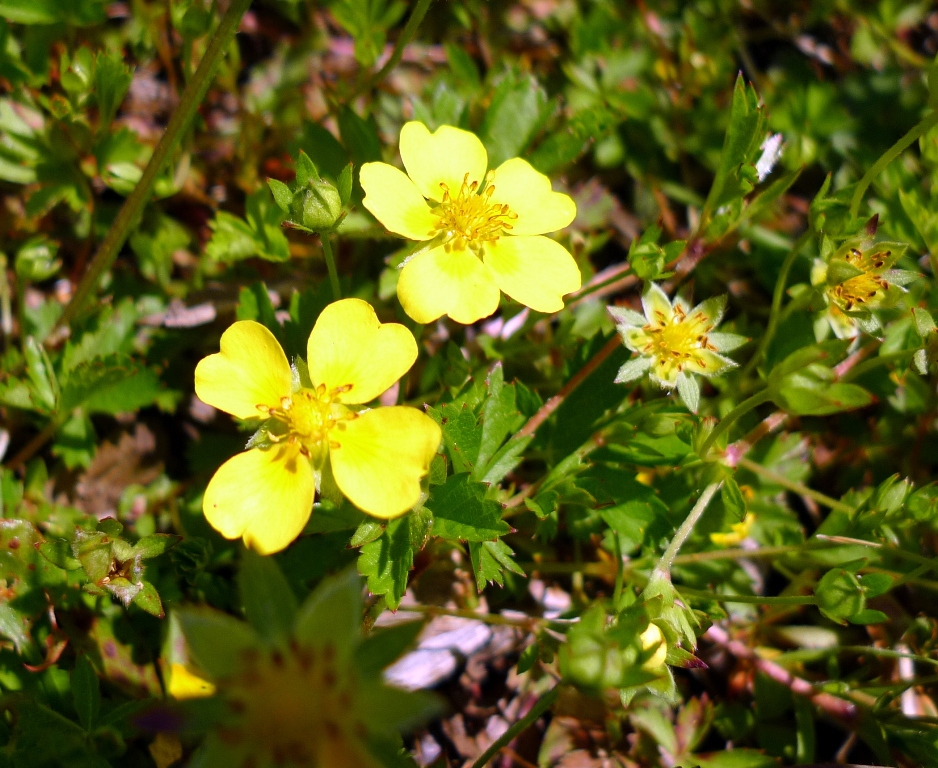
Potentilla x mixta (cross between P. reptans and P. anglica)
Potentilla verna (syn. P. tabernaemontani or Spring Cinquefoil
Potentilla rupestris or Rock Cinquefoil
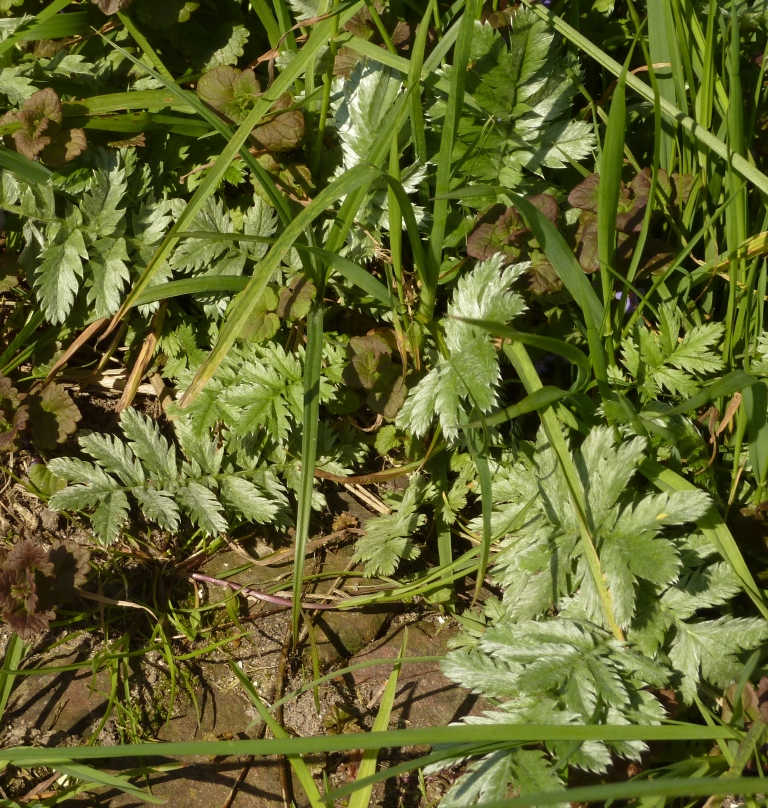
Potentilla anserina or Silverweed
This plant has a rich etymology and folklore:
The pre-Linnaean name anserina means “of the goose” (Anser), either because the plant was used to feed them or because the leaves reminded of the bird’s footmarks. In Sweden, the flower is called gåsört (goose-wort)
It bears the common name of richette in French, being rich through both silver (leaves) and gold (the flowers). There is a legend that the Christ Child grew up and walked the roads of Palestine; and the yellow flowering plant of the dusty wayside with silvery fern-like leaves that lay flat on the ground has been called the Footsteps of Our Lord.
Historic Uses:
The plant was put in shoes to absorb sweat. It was formerly believed to be useful for epilepsy, and that it could ward off witches and evil spirits.
The root resembles taste of parsnips; raw or cooked. It can also be dried and ground into a powder then used in soups etc or mixed with cereals. The roots are rather thin, though perhaps their size cold be improved in cultivation [note by Ken Fern of PFAF]. Young shoots are edible. A tea is made from the leaves.
Medicinal Uses:
It is less astringent than the related P. erecta, but it has a gentler action. The whole plant is antispasmodic, mildly astringent, diuretic, foot care, haemostatic, odontalgic and a tonic.
A strong infusion is used to check the bleeding of piles and to treat diarrhoea used as a gargle for sore throats. Externally, it is used as a powder to treat ulcers and haemorrhoids whilst the whole bruised plant, placed over a painful area, will act as a local analgesic.
Potentilla sterilis or Barren Strawberry
Fragaria vesca or Wild Strawberry
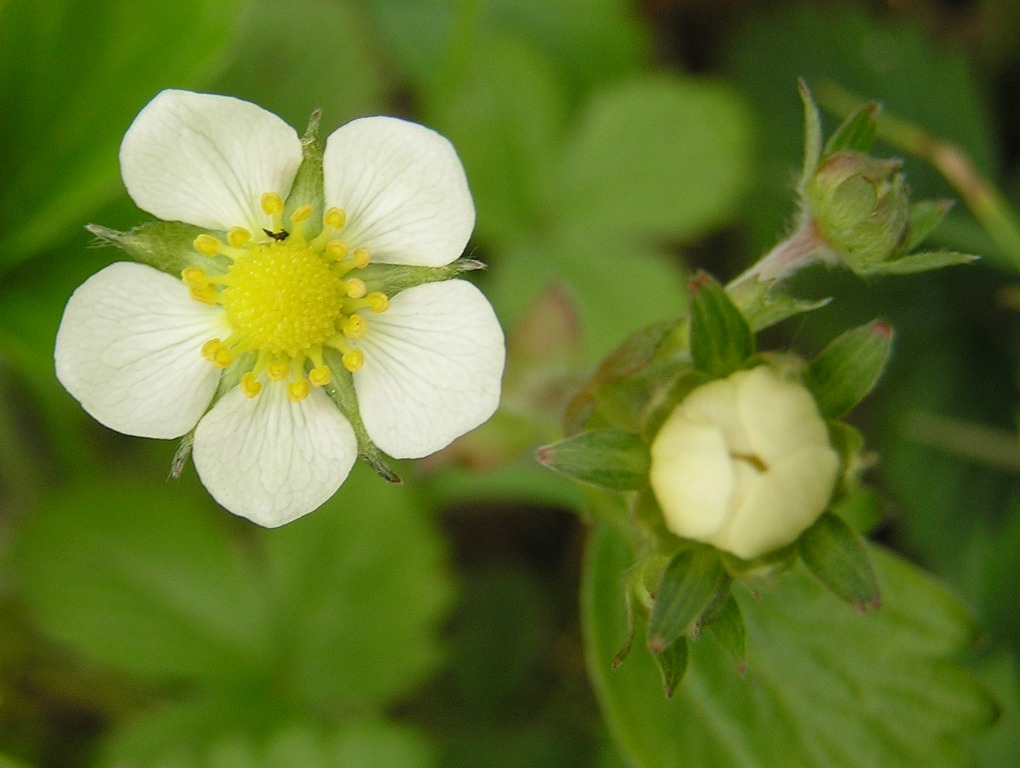
There is some confusion according to Wikipedia and Stace between the wild strawberry and the alpine strawberry.
Stace says: the robust variant often seen in gardens is without stolons and with flower and fruit produced continuously until the frost and is known as the alpine strawberry, which may escape to the wild.
Evidence from archaeological excavations suggests that Fragaria vesca has been consumed by humans since the Stone Age.
Woodland or Wild strawberry fruit is strongly flavoured, and is still collected and grown for domestic use and on a small scale commercially for the use of gourmets and as an ingredient for commercial jam, sauces, liqueurs, cosmetics and alternative medicine.
Comarum palustre or Marsh Cinqufoil
Dryas octopetala or Mountain avens
D. octopetala is cultivated in temperate regions as ground cover plant, or as an alpine or rock garden plant. It has gained the Royal Horticultural Society‘s Award of Garden Merit.
The leaves are occasionally used as a herbal tea.
Alchemilla vulgaris or Lady’s -mantle
A smaller version of the very attractive herbaceous perennial grown in gardens called Alchemilla mollis! This can easily get invasive so best to cut plants back after flowering so it won’t seed all over the place.
Alchemilla alpina or Alpine Lady’s-mantle
Alpine lady’s-mantle has been used for centuries as an herbal remedy, and is used in horticulture as a ground cover and in rock gardens.
Aphanes arvensis or Parsley-piert
Historic use:
It was wrongly assumed that the plant could pierce stones; and it was thought that a medicine made of parsley piert would break up stones in the bladder and kidneys. Old folk-names for the plant include ‘colicwort’ and ‘bowel-hive-grass’ (hive meant inflammation), showing that it was also used for intestinal ailments.
The 17th-century herbalist Nicholas Culpeper, recommended parsley piert for use in salads, although it would be difficult to gather sufficient quantities of such a tiny plant for a reasonable meal. Culpeper also recommends the plant to gentlemen for eating as a winter pickle in addition to the pickled samphire to which they were accustomed.
Medicinal Uses:
Parsley-piert has a long history of folk use, being commonly employed to rid the body of stones in the kidney or bladder. It has become a highly respected herb in modern herbalism for the treatment of kidney stones, recurrent urinary infections, jaundice etc. It promotes the flow of urine in combination with other herbs.
Aphanes australis or Slender Parsley-piert
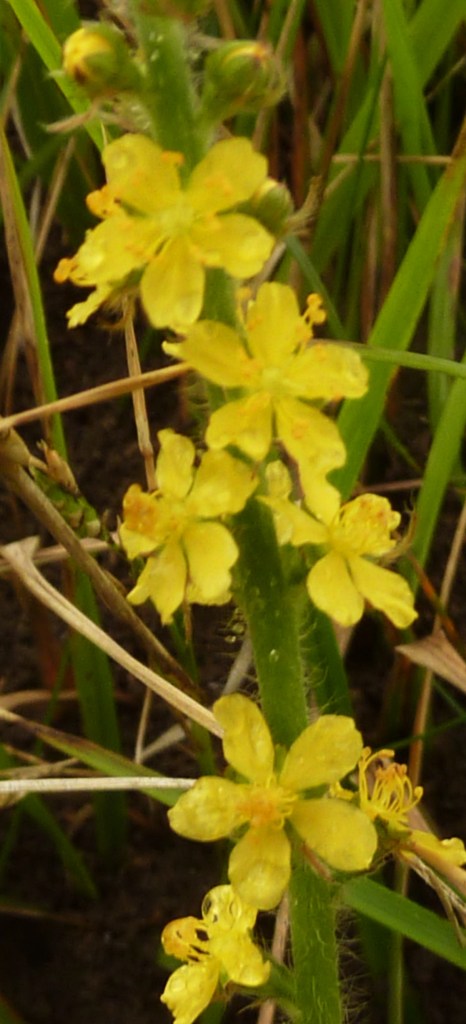
Agrimonia eupatoria or Agrimony
A. eupatoria or Agrimony is a foodplant for the caterpillars of the snout moth Endotricha flammealis.
Edible uses:
The seed was dried and ground into a meal. A famine food, used when all else fails. This report could refer to A. pilosa.
A refreshing tea is made from the fresh or dried leaves, flowers and stems. It was formerly very popular either on its own or added to China tea, having a peculiar delicacy and aroma.
Medicinal Uses:
Agrimony has long been used as a popular domestic herbal remedy.
The whole plant is antiaphonic, astringent, blood purifier, cholagogue, diuretic, tonic and vulnerary.
- Has a great reputation in the treatment of jaundice and other complaints of the liver.
- Used to treat diarrhoea and as a gargle for sore throats.
- Externally, a strong decoction is used to treat wounds, skin problems, haemorrhoids etc.
- The plant is used in Bach flower remedies – the keywords for prescribing it are ‘Mental torture’ and ‘Worry, concealed from others’.
Don’t use with hypersensitivity to plants from rose family. Don’t use in pregnancy and during lactation.
Agrimony procera or Fragrant Agrimony
Sanguisorba minor or Salad Burnet
Edible Uses:
- Raw or cooked, young leaves and shoots.
- In salads, used as a garnish or added to soups, cooling drinks and claret cups.
- A herb tea is made from the dried leaves
Medicinal Uses:
The root and the leaves are astringent, diaphoretic and styptic, though the root is most active.
- The plant is an effective wound herb, quickly staunching any bleeding. For the treatment of gout and rheumatism.
- An infusion of the leaves is used as a soothing treatment for sunburn or skin troubles such as eczema.
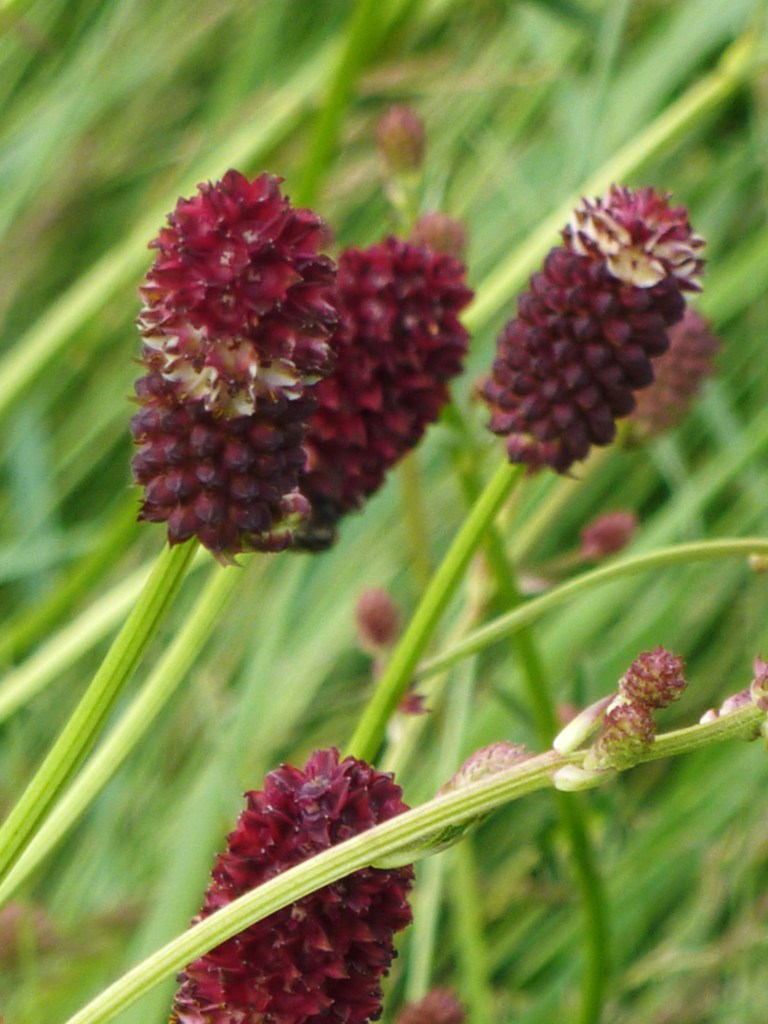
Sanguisorba officinalis or Great Burnet
Edible Uses:
- Raw or cooked, young leaves and shoots. Cucumber flavour.
- In salads, used as a garnish or added to soups, cooling drinks and claret cups.
- A herb tea is made from the dried leaves
Medicinal Uses:
The leaves are astringent, refrigerant, styptic and tonic.
- They are used in the treatment of fevers and bleeding.
The root is anodyne, astringent, diuretic, febrifuge, haemostatic, tonic and vulnerary.
- It is an excellent internal treatment for all sorts of abnormal discharges including diarrhoea, dysentery and leucorrhoea. It is used externally in the treatment of burns, scalds, sores and skin diseases.
Filipendula ulmaria or Meadowsweet
This whole herb possesses a pleasant taste and flavour, the green parts having a similar aromatic character to the flowers, leading to the former use of the plant as a strewing herb, strewn on floors to give the rooms a pleasant aroma,
Meadowsweet has many other lovely names such as; queen of the meadow, pride of the meadow, meadow-wort, meadow queen, lady of the meadow, dollof, meadsweet, and bridewort.
Interesting note:
Chemical constituents include salicylic acid, flavone glycosides, essential oils, and tannins. In 1897, Felix Hoffmann created a synthetically altered version of salicin, derived from the species, which caused less digestive upset than pure salicylic acid. The new drug, formally acetylsalicylic acid, was named aspirin by Hoffmann‘s employer Bayer AG after the old botanical name for meadowsweet, Spiraea ulmaria. This gave rise to the class of drugs known as non-steroidal anti-inflammatory drugs (NSAIDs).
But: This remedy should not be given to people who are hypersensitive to aspirin!
Edible and Other Uses:
- The leaves are used to flavour wine, beer, and vinegars. The dried leaves are also used as a flavouring as a sweetener in herb teas.
- The flowers can be added to stewed fruit and jams, giving them a subtle almond flavour. Dried, the flowers are used in potpourri. It is also a frequently used spice in Scandinavian varieties of mead.
- A natural black dye can be obtained from the roots by using a copper mordant.
- An ornamental plant for the bog garden.
Medicinal Uses:
Meadowsweet has a very long history of herbal use; it was one of the three most sacred herbs of the Druids.
The leaves and flowering stems are alterative, anti-inflammatory, antiseptic, aromatic, astringent, diaphoretic, diuretic, stomachic and tonic
A tea made from Filipendula ulmaria flowers or leaves has been used in traditional Austrian herbal medicine for the treatment of rheumatism, gout, infections, and fever.
The whole plant is a traditional remedy for an acidic stomach, and the fresh root is often used in homeopathic preparations.
- The herb is a valuable medicine in the treatment of diarrhoea, indeed it is considered almost specific in the treatment of children’s diarrhoea.
- Is used to treat hyperacidity, heartburn, gastritis and peptic ulcers.
- In the treatment of afflictions of the blood
- Effective against the organisms causing diphtheria, dysentery and pneumonia
- A strong decoction of the boiled root is said to be effective, when used externally, in the treatment of sores and ulcers,
Filipendula vulgaris or Dropwort
Interesting is that this species grows in the opposite habitat as the previous plant.
Edible and Other Uses:
- An attractive ornamental plant.
- The crushed leaves and roots have a scent of the oil of wintergreen (methyl salicylate).
- The young leaves can be eaten raw or cooked. They can be added to salads and soups. The roots either raw or cooked are rather bitter & astringent. Best if roasted.
A famine food, it is only used in times of scarcity!
Medicinal Uses:
The root is anthelmintic and lithontripic.
- It is used in the treatment of epilepsy, kidney and bladder stones, genital discharges and intestinal worms.
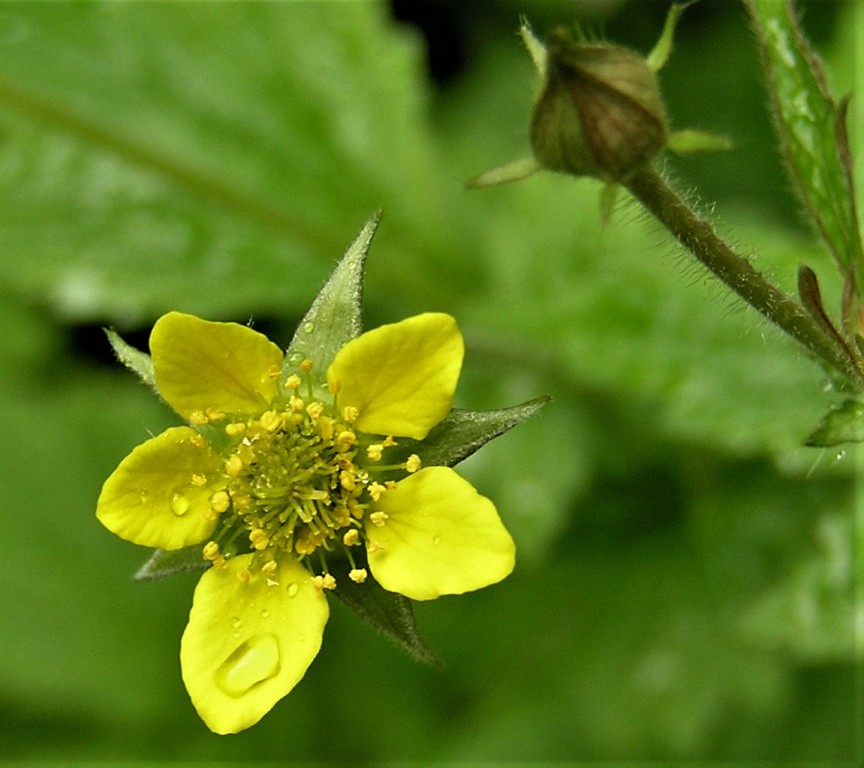
Edible Uses:
- The young leaves and roots are cooked and used as a spice in soups, stews etc, and also as a flavouring in ale.
- It is a substitute for cloves with a hint of cinnamon in the flavour. It is best used in spring.
- The root is also boiled to make a beverage.
Medicinal Uses:
Wood avens is an astringent herb, used principally to treat problems affecting the mouth, throat and gastro-intestinal tract. It tightens up soft gums, heals mouth ulcers, makes a good gargle for infections of the pharynx and larynx, and reduces irritation of the stomach and gut.
All parts of the plant, but especially the root, are anti-inflammatory, antiseptic, aromatic, astringent, diaphoretic, febrifuge, stomachic, styptic and a tonic.
- An infusion is taken internally in the treatment of diarrhoea, intestinal disorders, stomach upsets, irritable bowel syndrome and liver disorders,
- it is also applied externally as a wash to haemorrhoids, vaginal discharges etc. and to treat various skin afflictions
- it is said to remove spots, freckles and eruptions from the face.
- The powdered root had a great reputation as a substitute for quinine in the treatment of intermittent fevers.
G. rivale is pollinated primarily by bees, less often by flies and beetles.
Uses as an ornamental plant in a border with damp soil such as in the bog garden!
This is most of our true native Rosaceae covered.

